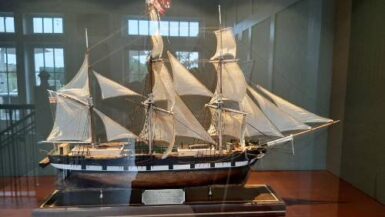
“Ye friends that weep about my grave
Compose your minds to rest
Prepare with me for sudden death
And be forever blest”
That is the chilling epitaph on the forlorn, grey tombstone standing sentinel over wealthy oxen farmer Baltus Roll’s lonely grave in a northern New Jersey Presbyterian burial ground. His was a pioneering family in the region, so they were rumored to be wealthy with a hidden fortune, and on the night of February 22, 1831 two ne’er-do-wells named Peter Davis and Lycidiac Baldwin broke into Roll’s house, hog-tied him, and threw him in a pool of icy water in an effort to get him to give up the location of his cache.
Roll’s wife escaped, fleeing to a neighbor who rallied the town, but Baltus’s lifeless body and an overturned house were all they found when the posse arrived at Roll’s estate.
The Manhattan dailies called it “The Crime of the Century” – the vicious home invasion and murder of the prosperous mountaintop farmer who lived high atop the forested hills near Springfield. and to this day, according to locals, the ghost of “Old Balty” still stalks the slopes, the hilltop, the forest, and the golf courses that bear his name. So begins the story of fabled, venerable Baltusrol Golf Club, still the only facility to have both of its courses – the Upper and the Lower – host U.S. Opens.
Yet the tales of the major championships conducted there are not as frightening as the tale of the man whose name the club bears. Even though both courses were designed by A.W. Tillinghast, a.k.a. Tilly the Terror, Baltusrol has seen a disproportionate amount of record setting performances for such a well-pedigreed Golden Age club. Winged Foot and Oakmont range anywhere from “stern test” to “torture chamber” depending on how furious the tournament director’s wife is at him when he sets the pins. But over the years, the players have had a habit of lighting up Baltusrol like a Gottlieb pinball machine, and it’s not just Hall of Famers doing it, but journeymen and club pros as well.
HISTORY
The first two Opens at Baltusrol were contested over the Old Course, which is now NLE, (that’s “No Longer Exist” in the vernacular) and they were won by immortals. Scotland’s Willie Anderson claimed the 1903 Open, the second of his record four titles and the first of three in a row. He’s still the only golfer to ever “three-peat” at the U.S. Open. Then in 1915 Jerome Travers won his only U.S. Open, to go along with a total of four U.S. Amateur titles. He’s still regarded as one of the greatest match play golfers in history, winning his four Amateurs by a whopping combined total of 26 and 21, or roughly 7&5 per match.
Tillinghast completed designing the Upper and Lower courses in the early 20’s but the Open didn’t return to Baltusrol until 1936, and that’s when the puzzling strangers start to appear. Tony Manero was obscure to everyone except his wife and playing partner Gene Sarazen when he won on the Upper Course in ’36, (the only time the Open was contested on the Upper).
Manero also started a trend that year, setting a U.S. Open aggregate record with a total of 282, and from then on Baltusrol, over time, became known as one of the best chances not only to go low at the Open, but to rewrite history.
If you needed a spotters guide to figure out who Manero was, that was nothing compared to the 1954 Open, when the Lower Course made its U.S. Open debut and club pro Ed Furgol made the Open his first professional win. (Manero had at least won on the tour five times before winning in ’36.)
Furgol had everything working against him. For openers, he had a severe physical disability – a withered left arm that was 10 inches shorter than his right. While some media reports attributed this to polio or some other disease, that wasn’t the case.
“Do you know how many times I’ve had to debunk that story?” bellowed Ed’s nephew Hank, himself a golf pro, a second generation one in fact, at Valley View Golf Course in Utica, New York, (a place locals colorfully refer to as “Bushwood,”). The charmingly irascible, silver-haired, short-game master with the caddie hustler swing and matching demeanor slams a copy of the September 4, 1954 edition of the Saturday Evening Post on the pro shop counter.

“My uncle wrote this article right after he won. He fell off a playground gym set trying to impress some older kids.”
Indeed, the Saturday Evening Post article proves invaluable on this score and many others, as it Ed Furgol’s first-person narrative tracing both his personal story and the tale of the ’54 Open. Also, it’s written shortly thereafter, so everything was fresh in his memory.
It seems the fall from the playground gym set resulted in a compound fracture, bone grotesquely piercing through the mangled flesh. After five months on his back with his arm raised in the air, when the cast came off, Furgol described the aftermath:
“My left arm was virtually useless. It was withered from the elbow to the shoulder, no bigger than a mashie shaft. I determined I wasn’t going to be an invalid. I did everything possible to rebuild the strength…”
Furgol turned to boxing and golf and became so good at both, he had the talent to turn pro in either. Golf prevailed, but after a decade of lean years, he seemingly retired to the quiet life of country club pro at St. Louis’ Westwood Golf club. Furgol was so much of an afterthought for the Open that the St. Louis newspapers didn’t send a man out to cover the tournament. As a further insult, Furgol had to take a cab to the golf course at a premium expense while fellow Dunlop-sponsored golfers like Bobby Locke got swank courtesy cars.
“I was given to understand I could ride with Locke when convenient. This wasn’t often….Locke likes to lounge around till noon. Besides, we had different starting times,” Furgol wrote in an article he penned for the September 4, 1954 edition of the Saturday Evening Post. “So I rode a cab to the course. It cost me six bucks each time.”
Furgol even got short-changed when it came to a caddie, drawing a man who wasn’t a Baltusrol regular.
“Not only did he know nothing about the course, he had very little knowledge of golf. At no time during the entire three days and seventy-two holes of golf did I ask him for one bit of advice,” Furgol wrote. On two or three occasions I pleaded with him to keep my irons clean – he would leave the grooves and face of the clubs dirty.”
With seemingly everything against him, Furgol’s 4-over 284 total took the title by one shot over Gene Littler, and featured one of the great clutch golf shots in golf. After hooking deep into the woods on the par-5 72nd hole, Furgol played his second down the adjacent 18th fairway. His 8-iron over the trees from the wrong fairway with the title on the line has, sadly, faded into history since neither video nor photograph captured it.
As an aside, even back then, winning the Open was a life-changing event. Despite being an unknown beforehand, Furgol cut quite the debonair figure, looking very much like a cross between Humphrey Bogart and Bela Lugosi – the aquiline nose, slicked-back hair and bushy eyebrows of Count Dracula and the thoughtful furrowed brow and dark swarthiness of café owner Rick Blaine. After he won the Open, Furgol was often seen in the company of beauty queens like BeBe Shopp and Idell Hulin. They never stood a chance though; Furgol’s wife helped him work the pro shop at the country club back home.

THE MODERN ERA
Baltusrol next saw the Open in 1967, just in time for the meteoric rise of Jack Nicklaus. That week Jack rewrote the biggest records in the book – lowest final round to win and lowest 72-hole aggregate. Before there was Miller’s 63 at Oakmont to close and win the 1973 Open, there was Jack’s 65 at Baltusrol to win by four shots over an overmatched Arnold Palmer. Before there was Rory’s 268 at Congressional in 2011, there was Jack’s 275 on the Lower Course to shatter the aggregate record.
The highlight of the closing 65 was the racing away from Arnold Palmer like Arnie was standing still. Nicklaus punctuated the win with a scalding, 238-yard 1-iron from the rough to hit the 18th green in two and finish with a birdie that put him at 5-under. The club sunk a plaque to commemorate the shot. After all, it was vintage Jack in his prime.
“I never had a chance,” a shell-shocked Palmer said later. “Jack’s focus and precision were unstoppable”
An old column by Nicklaus sheds light on why Baltusrol has a history of being player-friendly when major championships. “Fairways were particularly wide for a U.S. Open, and the rough was unusually short, he wrote. You could advance the ball to the green,” he wrote.
There was also one more fascinating nugget of trivia in the article – an unfiltered Nicklaus expressed his dislike for net work television mandating late starts for the leaders:
“I had one more thing to dislike that evening: television. This was about the time when the networks began to exert the pressure on golf’s administrators that today has given them almost total control over the timing of the weekend tournament rounds. The broadcast decreed seven o’clock finishes, which meant Arnie and I would not tee of until three in the afternoon…Barb and I yawned though Casper the Friendly Ghost, The Winsome Witch, a Bob Hope movie, then most of Randolph Scott in “Riding Shotgun” before it was time to leave for the course. B-o-r-i-n-g…”
Boring never described Nicklaus, though, and when he returned to Baltusrol in 1980, he did it again; he electrified the golf world with a multiple-record setting performance. Get this: he broke the 18-hole scoring record, (63), the 36-hole scoring record, (134), the 54-hole scoring record, (204), and he 72-hole scoring record (272).
A 63 to open will go a long way if you’re the Golden Bear.
This was after Nicklaus had gone winless in almost two years. It woke everybody up with a thunderclap, and chants of “Jack is back” started to echo through the wooded fairways.
It wasn’t a golf tournament, it was a rock concert.
Unfortunately for the Lower Course, Tom Weiskopf did exactly the same thing the first day – shoot a 63: Baltusrol surrendered two in one day, and that’s only happened one other time in a major. Nick Faldo and Payne Stewart both shot final round 63s at the Open Championship at St. George’s in 1993, (talk about a statistical outlier), but neither of them won. Baltusrol would eventually surrender another 63 in a major championship, to Thomas Bjorn in the third round of the 2005 PGA, won by on a Monday finish by Phil Mickelson. Bjorn, along with Steve Elkington finished second by a single stroke. Incidentally, Mickelson, who needed a birdie on the final hole to win, walked over to the Nicklaus plaque on 18 and tapped it twice with his 4-wood before launching the shot that help secure him the championship.
But back to 1980 and Jack – Nicklaus had an unlike pebble in his shoe that week. Jack had to birdie the last two holes, both par-5s, to finally break free of plucky Isao Aoki, who finished two shots back. Aoki, you’ll recall, was the complete unknown from Japan who putted with the toe of the putter pointed up in the air while striking the ball with the heel of the club.
“It would have been the best clown act in sports, except the ball kept going in the hole,” wrote Dan Jenkins in his tournament recap.
Aoki also broke the old Nicklaus record of 275 with his 6-under 274, once again demonstrating how comparatively easy Baltusrol plays for Opens. Even Tom Watson, who finished at 276 was left shaking his head.
“I just shot the fourth lowest score in U.S. Open history and I came in third and lost by four shots,” he surmised after the round.
It’s one thing for Jack Nicklaus to treat the U.S. Open record book like his own private amusement park, but when a journeyman pro like Lee Janzen does it, it’s time for a painstaking reappraisal. Janzen was a typical milquetoast, 1990s, methodical plodder of a golfer who suddenly turned into Jack when he arrived at Baltusrol for the 1993 U.S. Open. Janzen shot all four rounds in te 60s, tied Nicklaus’s 36-hole scoring record of 134, broke Nicklaus’s 54-hole scoring record with 203, and tied Nicklaus’s 72-hole scoring record of 272 as well as his 8-under score-to-par record.
Janzen tying the scorin record of Jack Nicklaus? Thaat’s almost as bizarre as Ed Gibstein tying a record of Walter Travis’s at Garden City…almost…
Janzen’s 272 marked the third consecutive time that the U.S. Open scoring record was set at Baltusrol. It hasn’t hosted a U.S. Open since.
Some people believe that the USGA declines bringing the Open back to Balty because the tournament is supposed to be golf’s toughest test, and the Lower Course proved tome and again that it wasn’t worthy of the mantle – from a scoring perspective only, but when your identity is that of a Final Examination in Golf (Capital F, E, and G), you can’t have the equivalent of a true-false section on the test.
When the PGA Championship arrived in 2005 along with five-inch U.S. Open rough and supermodel slim fairways, everyone thought the problems of the past would be obviated and we’d have a U.S. Open in August…that is until Thomas Bjorn’s 63 on Saturday. What’s that Talking Heads lyric? “Same as it ever was…same as it ever was…”
The PGA of America also didn’t avoid the ignominy of yet another record shattering week at Balty – Phil’s winning score was 4-under 276, but he did open with a blazing 67-65 for a two-day total of 132, the lowest at any major yet contested over the Lower Course.
So the truth is out. Start licking your chops when Baltusrol comes around because besides the stately, Golden Age grandeur of the clubhouse and hospitality, you can go out and play golf for the title, not tiptoe around a minefield of unexploded double bogeys. Old Balty may be the friendliest ghost since Casper…or maybe the Winsome Witch.
Will we see another 63? There’s been a few floating around of late, (Stenson and Mickelson last week at Troon). We’ve also seen two 20-under scores at majors in he last 11 months, (Stenson and Jason Day).
Twice in the span of less than one year, the all-time major championship scoring record was broken…I’m. Just. Sayin’.
With that in mind, you can be certain the PGA of America doesn’t want Baltusrol to endure the ignominy of another record shattering performance, so the rough will be up, the fairways narrower than usual, and the green speeds ratched up to “Parquet Floor” setting. Indeed, the latest reports from Balty are that the rough is long, thjck, and juicy. Even so, there’s only so much supercharge you can put into the Lower Course, so don’t expect a U.S. Open in July either. With today’s pros firing carronades at flags after strengthening in the gym, it’s only time before someone finally shoots 62. It might not be this week, but with Erin Hills, Royal Birkdale, and Quail Hollow coming up next year it may finally happen.
NEWS, NOTES, AND QUOTES
Ed Furgol: “My luck is so bad, if I bought a cemetery, people would stop dying.”






